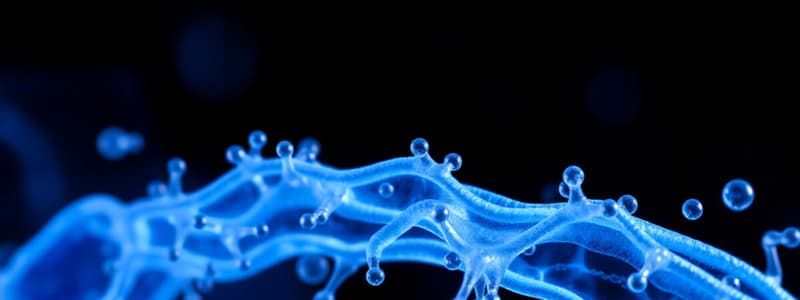Podcast
Questions and Answers
What is the primary function of tissues in biological organization?
What is the primary function of tissues in biological organization?
- To interact with different populations in an area
- To form different organ systems
- To specialize and work together for a specific function (correct)
- To perform all life's processes independently
At which level of biological organization do emergent properties first begin to arise?
At which level of biological organization do emergent properties first begin to arise?
- Atomic Level
- Molecular Level
- Cellular Level (correct)
- Organ System Level
Which of the following substances is a molecule necessary for life?
Which of the following substances is a molecule necessary for life?
- Carbon atom
- Water (H₂O) (correct)
- Hydrogen atom
- Oxygen atom
What is defined as a group of individuals of the same species living in the same area?
What is defined as a group of individuals of the same species living in the same area?
Which level of biological organization encompasses all organ systems functioning together?
Which level of biological organization encompasses all organ systems functioning together?
What is the role of organ systems in organisms?
What is the role of organ systems in organisms?
At what level are groups of different species interacting within a specific area?
At what level are groups of different species interacting within a specific area?
Which of the following is NOT a characteristic of a population?
Which of the following is NOT a characteristic of a population?
Flashcards
What are atoms?
What are atoms?
The fundamental building blocks of all matter, including living organisms.
What are molecules?
What are molecules?
Groups of atoms bonded together, forming the basis of cellular structures and functions.
What are cells?
What are cells?
The smallest units capable of independently performing all life processes.
What are tissues?
What are tissues?
Signup and view all the flashcards
What are organs?
What are organs?
Signup and view all the flashcards
What are organ systems?
What are organ systems?
Signup and view all the flashcards
What is a population?
What is a population?
Signup and view all the flashcards
What is a community?
What is a community?
Signup and view all the flashcards
Study Notes
Introduction
- Biological organization describes the hierarchical arrangement of living things, from atoms to ecosystems.
- Each level builds upon the one below, with emergent properties arising at higher levels.
- Understanding these levels is key to grasping the complex interactions within and between organisms.
Atomic Level
- Atoms are the fundamental building blocks of all matter, including living organisms.
- Atoms combine to form molecules.
- Examples of atoms vital to biology include carbon, hydrogen, nitrogen, and oxygen.
Molecular Level
- Molecules are groups of atoms bonded together.
- Examples of molecules include water (H₂O), proteins, carbohydrates, and DNA.
- These molecules form the basis of cellular structures and functions.
Cellular Level
- Cells are the basic units of life.
- They are the smallest units that can perform all life's processes.
- Different types of cells exist, specialized to perform different functions.
Tissue Level
- Tissues are groups of similar cells that work together to perform a specific function.
- Examples of tissues include muscle tissue, nervous tissue, and epithelial tissue.
- Tissues combine to form organs.
Organ Level
- Organs are groups of different tissues working together to perform a specific function.
- Examples of organs include the heart, lungs, and brain.
- Organs contribute to the function of organ systems.
Organ System Level
- Organ systems are groups of organs working together to perform a broad function.
- The circulatory system (heart, blood vessels), the respiratory system (lungs), and the digestive system (stomach, intestines) are examples.
- Organ systems work interdependently to maintain homeostasis.
Organism Level
- An organism is an individual living entity.
- It encompasses all the organ systems functioning together.
- Organisms exhibit complex interactions and behaviours.
Population Level
- A population is a group of individuals of the same species living in the same area.
- Populations interact through competition for resources and reproduction.
- Populations can have certain characteristics; for example, size and density.
Community Level
- A community consists of all the populations of different species living and interacting in a particular area.
- Species within a community interact through predator-prey relationships and competition.
- Various different interactions occur, such as competition, predation, parasitism, and mutualism.
Ecosystem Level
- An ecosystem encompasses all the living organisms (biotic factors) in a particular area and the non-living (abiotic) environment.
- Abiotic factors include sunlight, water, temperature, and minerals.
- Ecosystems are dynamic, exhibiting interactions between living and non-living components.
Biosphere Level
- The biosphere is the global sum of all ecosystems.
- It encompasses all life on Earth and the environments that support it.
- The biosphere encompasses all the populations, communities, ecosystems, and their interactions.
Studying That Suits You
Use AI to generate personalized quizzes and flashcards to suit your learning preferences.




